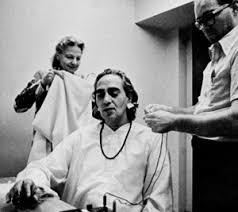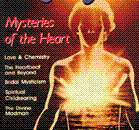
The Heart
The following excerpts provide an overview of Man’s intuition of the heart, the spiritual core of his being. As will be seen, from ancient times to the present, and in many different cultures, the heart center has been considered the vehicle for recognizing or understanding the Truth. Note: quotations which do not represent the fifth stage point of view have been included in order to provide a fuller picture.
“It is the heart which experiences God, and not the reason. This, then, is faith. God felt by the heart, and not by the reason.”
Blaise Pascal, Pensees, 278
Sakalya said: ‘And in what does the True abide?’ Yagnavalkya said: ‘In the heart, for with the heart do we know what is true, and in the heart indeed the True abides.’
Brihadaranyaka Upanishad 111.9.23
When the mind and heart are united in prayer and the thoughts of the soul are not scattered, then the heart is warmed with a spiritual warmth, wherein shines the light of Christ, filling with peace and joy the whole inner man.
St. Seraphim, The Spiritual Instructions of St. Seraphim of Sarov, p. 24
[At death,) the warmth finally gathers at the heart, from which the consciousness exits. Those particles of matter, of combined semen and blood, into which the consciousness initially entered in the mother’s womb at the beginning of the life, become the centre of the heart; and from that very same point the consciousness ultimately departs at death.
Lati Rimbochay and Jeffrey Hopkins, Death, Intermediate State and Rebirth in Tibetan Buddhism, pp. 9-10
Jivatman, the individual soul, abides in the Bliss Sheath situated in the space of the heart, the reservoir of blood…. It can be seen by divine vision that this human body, which is like a castle … contains the heart, of the size of a pear, or like the lotus bud drooping downwards. Inside this heart is a hollow of the size of a small seedless grape. Inside this hollow is the Bliss Sheath, luminous like a golden egg. This Bliss Sheath is an aggregate of six luminous orbs. It is very pleasant to see and appears like an oval mass of light.
Swami Yogeshwaranand Saraswati Ji Maharaj, Science of Soul, p. 186

Our study in 1971 of Swami Rama, a yogi from Rishikesh, India, produced a few self-regulation events in our lab which represented, he said, energy control (see Beyond Biofeedback, Delta Books, Dell Publications, 1978, for details). For instance: Before he put his heart into a state of atrial flutter he turned to Alyce, who was on her way to the lab’s control room, and said, “When my heart ‘stops,” call over the intercom and say, ‘That’s all.'” I immediately asked why he wanted that, and he said, “Since I am not prepared in the usual way for this experiment, I do not want to do it too long . . do not want to take a chance on damaging my subtle heart.”
Later when I had, a chance, I asked Swami how he managed to put his heart into the peculiar nonpumping state of atria) flutter, and he said that a large energy center in the center of his chest (the “heart cakra in the subtle body”) was connected, by a little line of “light” (prana, or chi) to a small energy center in the right ear. In a state of meditation he “looked” inside himself, and when he saw the line of light he made it become “very bright,” and then the heart “stopped.” Many months later, at a meeting of neurologists for whom I was speaking, I was – pressed by one questioner to explain how the Swami did that “trick.” I decided to give the Swami’s own’, explanation, since I said I had no other. After that explanation-there was a long heavy silence.; Then one of the physicians stood up and offered an explanation. There is a loop of the vagus nerve (which controls the heart) very close to the right ear. The Swami obviously had learned a way to manipulate it. “Isn’t it interesting,” the doctor said, “the Swami has developed a metaphor’ (a visualization, please note) which when thought about is able to manipulate the vagus nerve!” I did not say, it, but I thought, “Who really has the metaphor, the doctor or the Swami?”
Elmer Green, from a talk given at the Mandala Holistic Health conference in San Diego.
In the condition of atria) flutter, the heart does not actually stop. Instead, the atrium begins to beat quite rapidly (250-400 beats per minute) independently of the pacemaker. The ventricle is unable to respond this rapidly and begins to heal at ita vwn late (uoually 150-20U beats per minute) Consequently, the pumping action of the heart is impaired.
Now, whereas the experience of the awakening of kundalini in man floods the genitals and causes spontaneous erection in meditation, the equivalent experience in the woman causes an ecstatic rapture that can be described as “an orgasm of the heart,” or “giving birth in the heart.” The sudden opening of the heart … causes an ecstatic experience of illumination; the heart of the woman becomes the heart of the universe. The Sufi image of this experience is the winged heart. It is for good reason that the sculptor Bernini pictured St. Teresa in ecstasy as a woman in orgasm with an angel opening her heart with an arrow.
Irwin Thompson, The Time Falling Bodies Take to Light, p. 19
Paracelsus, the supreme physician of the Renaissance, steeped in the mystical traditions of Europe, described this ‘dweller in the heart’ as a bluish flame-like body, equal in size to the last joint on a man’s thumb. The Taoist adepts of China likened the heart to a chamber of fire located between heaven (the head) and earth (the abdomen), and said that its transmutation led to immortality. Arab physicians of the past have claimed that if a certain point in the heart of a living animal be touched with the finger the heat is so intense as to cause a blister.
David V. Tansley, Subtle Body, p. 13
Sister Maria Villani, a Dominican nun of Naples who believed that she had been pierced in the side and heart “by a fiery spear of love,” was 86 years old when she died in the latter 1600’s. At the moment of death her flesh was dark and shriveled, but afterward it changed miraculously, becoming “fresh-coloured and supple like that of a living person.”
Nine hours after her death an autopsy was performed, the first incision being made in the chest. But when this was done, smoke arose from the heart, to the great astonishment of those watching, and with it so much heat that the surgeon had to stand back. At length he moved his hand toward the incision again to withdraw the heart from the body, but the heat was still intense, and he was burned several times before being able to extract it.
Those present were then able to see and explore an open wound in the heart of exactly the same shape and size that Maria had herself once sketched of the puncture. “This wound (in the heart),” her biographer says, “I have seen and touched and examined. The lips of the wound are hard and seared, just as happens when the cautery is used, to remind us, no doubt, that it was made with a spear of fire.”
-Herbert Thurston, The Physical Phenomena of Mysticism, pp. 219-20
The Tongans thought that the soul extended through the body, but was mainly manifested in the heart, the pulsations of which were the power of the soul. The right auricle of the heart was the seat of life.
-W. Mariner, Tonga Islands, Vol. ii., p. 99
This [meditative practice] consists of quietly concentrating attention on the heart and the region between the heart and solar plexus, which is the physical correspondence of the Spiritual Heart; for there is the true tabernacle of the Divine Presence whose temple is the human body. It should be the focus of our careful attention, in order that we may be able to hear the voice of our Spiritual Witness, and maintain the vital Fire.
-Isha Schwaller de Lubicz, The Opening of the Way: A Practical Guide to the Wisdom of Ancient Egypt, p. 59
God who is concealed within the heart … O man meditate on the Name under the Guru’s instruction, and thou shalt be happy in the temple of thy heart. (Guru Nanak)
-Macauliffe, The Sikh Religion, Vol. I., pp. 317-18
What I call the Heart is consciousness. It is called Atman, the very Self or Nature of the apparent individual. It is not a separate organ or a separate faculty. It is identical to what is called Brahman, the formless, absolute, omnipresent Divine Reality. It is very consciousness, absolute bliss, unqualified existence. It is intuition of unspeakable God. Anything secondary that we could call “mind,” body, or brain, any function at all, is contained within the “Heart” like an event in a universe.
-Da Free John, The Method of the Siddhas, p. 10
The following is from the Laughing Man Magazine, Vol 4, No 2, 1983, pp. 62-63

“A fool may presume Realization to be his or her own, but one who realizes the True Heart, amazingly Ignorant, is only sacrifice, and forever.”
Adi Da Samraj – Paradox of Instruction – Chapter 2